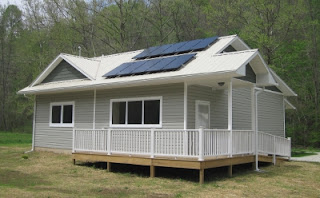When Hazel the Jersey milk cow moved to Kentucky with the kids she was bred and due to calf in the spring. She calved and Anders started hand milking her, but he soon realized his hands weren't going to hold up to the job and Hazel's patience for the slow process was wearing thin. So with no electricity in their barn and not really wanting to spend what it would take to get an electrical surge milker setup, they started looking for alternatives.
Anders spent some time online researching non-electric milkers and settled on the Henry milker. This little gizmo developed by Mr. Henry in Alaska arrived less than a week after the order was placed. Great service!! Gotta love cottage industry's attention to what is important.
Amazing! It was put together out of plastic tubing, the vacuum pump from a brake bleeding kit, and a 60cc syringe with the plunger discarded and a standard mason jar. One plastic hose line carries the milk into the jar and another creates a vacuum to pull it in and the syringe serves as the teat cup. It was originally developed for goat milking.
Anders made a couple of modifications to make it work better for Hazel. He added a couple of shut off valves in the lines and another teat cup to the set up so he can milk 2 teats at a time. He also changed from quart to 1/2 gallon mason jars so he didn't have to change bottles so often. He carries the whole set up to the barn in 2 milk crates.
Now twice a day, he brings Hazel into the barn and gets her settled with her feed in the stanchion. Then he washes down her udder. Next the valves are closed and the line pressurized by squeezing the vacuum pump. When the pressure is right, the teat cup is placed over the teat and the valve opened. The milk starts to flow almost immediately. I couldn't believe how simple it was. Anders sits on an upturned milk crate for a stool and watches the pressure gauge, occasionally giving it a few squeezes to keep the pressure up. As the milk bottles fill he shuts the valve and moves to another bottle. When a quarter is empty he shuts the valve moves the teat cup and opens the valve again. He sings quietly to Hazel as he works. It is all very calm, quiet and laid back. Not at all like milking was when we had Hazel and used a surge milker. No vacuum pump noise, no hurrying to be sure we got the teat cups off at the right time. No frenetic pulsing.
Now he is done milking in about 10 minutes with minimal effort, minimal noise and no electricity.
Hazel seems to like this arrangement too.


























